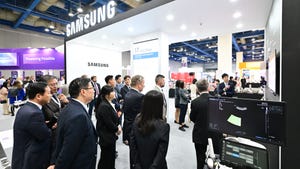Building a 5G-Ready Experience-Centric Converged Transport Network 748165
To compete with OTTs, operators must make the most of their advantages
December 11, 2018

Building a 5G-ready Experience-centric Converged Transport Network With the 5G era and ubiquitous connectivity now within reach, telecom operators are battling it out with industry peers and over-the-top (OTT) players to see who will be the first to supply the public with all the benefits that come with 5G.
Some traditional operators have started enhancing their full-service advantages and competitiveness by introducing IPTV and package bundling. Mobile operators, meanwhile, have been launching integrated fixed-mobile convergence (FMC) services to enhance customer loyalty and strengthen their service advantages. Full-service FMC operations have emerged as the most effective aspect of many operators' Mobile First development strategies.
Cross-industry competition from OTTs has shifted the focus of operators to services. However, operators are also facing challenges in their key area of expertise — transport networks. More OTTs, including Google, Amazon, and Alibaba, are building their own ultra-large data center (DC) nodes and backbone transmission networks, and are even expanding to cover metro networks. Leading OTTs are also developing last-mile plans to extend their networks to the access layer.
To compete with OTTs, operators must strengthen their advantages. There is a growing consensus that to achieve this, an operator needs to build a comprehensive, flexible, and intelligent transport network that provides outstanding user experience and meets service development requirements for full-service operations.
Figure 1: 
Operators will no doubt face a series of problems and challenges during network construction. First, how do they determine the high-value areas that require preferential construction during planning? Second, how can they construct networks in a quick, efficient, and cost-effective manner? Third, how do they ensure that O&M is efficient and automated? And fourth, how can they implement long-term future-proof evolution so as to guarantee competitiveness? Planning, construction, O&M, and evolution are interlinked and represent the main focus of most operators. Here is what we recommend:
Move fiber access points downstream to quickly access multiple services and improve competitiveness
To stay ahead of the competition, network access points must be moved downstream so they’re as close to customers as possible. Specifically, integrated service access points need to be constructed based on fiber networks to form integrated service access areas that cover homes, base stations, and enterprises. This allows an immediate response to requirements and quick service provisioning.
Pinpoint high-value customers and areas with big data analytics for precise planning
Planning the exact location of a fiber access point to develop more users and services is the main concern of operators when access points are moved downstream.
To help operators identify high-value areas and users, and plan the locations of their integrated service access points, Huawei provides the SmartCAPEX analytics tool. The data this tool analyzes includes the mobile phone locations of high-value users at night, user data quota consumption, enterprise and community distribution in a specified area, and the intensity of the competition. Services can then be quickly developed based on network planning to deliver strong coverage and short-distance access in combination with the cloud-based engineering tool. This tool and methodology have already been used by operators in a number of countries, including China, Costa Rica, Mexico, and Brazil.
Improve network construction efficiency and develop comprehensive services by collaborating on infrastructure
After the location of an access point has been determined, the network construction phase can begin. But any number of problems could occur, including difficult site and power acquisition. Building a transport network efficiently is the second major problem facing operators. However, with its rich experience, Huawei provides a diverse range of fast network construction solutions for different scenarios.
Use base stations as anchors and reuse mobile backhaul (MBH) network resources to quickly construct networks and develop comprehensive services
The most efficient and cost-effective network construction solution involves reusing MBH network resources by leveraging a large number of existing base stations and deploying short-distance last-mile fiber to cover nearby customers.
One operator in an area of Mexico City, for example, selected more than 20 fiber base stations according to home broadband requirements and its site resources, including site location and the availability of power supply, space, and backhaul bandwidth. It then deployed mini OLT devices inside mobile cabinets and laid out last-mile fibers within 300 meters to quickly provide fiber broadband services to the surrounding homes. The operator started receiving revenue just two months after the project was completed, shortening the payback period to less than two-and-a-half years. Another operator in Guangdong, China used its dense IP RAN networks to develop private line services for more than 1,000 high-value commercial buildings. Using its wide-coverage networks and fast service provisioning, the operator attracted hundreds of high-value private line customers in a year – a remarkable achievement.
Reuse fixed network cabinets, make them multi-purpose, and implement FMC for the rapid and low-cost deployment of mobile base stations
By reusing the existing street cabinets of a fixed network as a mobile site, an operator can quickly develop mobile services at low cost.
When developing its LTE networks, one Egyptian operator faced difficulties in site acquisition, high costs, and a long site construction period of five-to-six months. The operator then worked with Huawei on a joint innovation project. By adding side cabinets to existing fixed network cabinets, it solved the problem of site acquisition. The mobile base stations shared the power supply and backhaul fiber resources with fixed networks, shortening the deployment period by two to three months, reducing the overall cost by 30 percent, and greatly accelerating the provisioning time of the operator's mobile services.
Apply automation, intelligence, and cloud-and-network synergy to transport networks
Mobile Edge Computing (MEC) on mobile networks needs to be moved downstream, enterprise services must be moved to the cloud, and BNGs on fixed networks need to be virtualized. In the future, data centers (DCs) will no doubt be the convergence points of most services. The comprehensive transport network will also become a DC-centric network. Service traffic tends to be meshed, and the boundaries of traditional DCN, DCI, and MBH networks will become blurred and converged. This will require the transport network to be more flexible and elastic, allowing cloud-based services to be adjusted rapidly and the cloud and network to be synergized.
Based on the SDN-based on-demand network solution provided by Huawei, China Telecom provides its hospital customers with collaboration between agile private line and e-Cloud. In the daytime, regular bandwidth is used to ensure the transmission of medical data to the cloud. In the evening, the bandwidth can be flexibly expanded to synchronize large amounts of gene sequencing data to the cloud. For hospitals, this ensures service speeds, while reducing costs. Operators can also use idle bandwidth at night to improve bandwidth utilization.
Different services have different requirements and pose various challenges to transport networks. Compared with 3G/4G networks, 5G requires 10 times more bandwidth, millisecond-level latency, and massive numbers of connections. Video services on fixed networks focus on user experience. For services such as HD video, 3D video, VR, and AR, ensuring an optimal interactive experience without artifacts and freeze frames has become a major challenge for transport networks. The B2B private line service focuses on SLA assurance and fast TTM. To implement multi-service bearing, network slicing divides physical networks into different logical networks to provide differentiated network capabilities.
In the 5G era, the comprehensive transport network will be a simplified, intelligent, open, and elastic transport network that centers on distributed DCs, enables automation and intelligence through SDN, and provides slices for different services.
Adopt new protocols as the cornerstone for building comprehensive transport networks
IP will dominate future networks, and traditional architectures based on distributed control will slowly start to feature centralized SDN control. During this process, a series of new protocols, such as Segment Routing, EVPN, Telemetry, and NETCONF/YANG, will become the cornerstone of future comprehensive transport networks.
During the construction of 5G transport networks, leading operators in countries like Japan and South Korea and others in Europe require their networks to support new protocols, and plan to deploy these protocols on their networks. Huawei has actively participated in new protocol standardization, and chairs multiple working groups in the IETF standards organization. It’s also an active promoter of and contributor to new protocol standards.
Apply precise planning, platform readiness, and gradual evolution
That future networks will be multi-service cannot be denied. However, some factors regarding service network construction, such as the location of mobile MEC, the pace of bandwidth development, and intelligent O&M requirements, are still uncertain. To cope with the uncertainties, the architecture of the transport network, which serves as an infrastructure network, must be flexible and feature an agile and intelligent management and control system.
Much like a city's sewage network, transport networks need to be planned in advance and deployed phase by phase based on service development. Today, the total length of the sewers in Paris exceeds 2,300 kilometers, far beyond the length of the subway lines in the Paris Métro. This makes it the world's most prestigious sewage system, as well as the only underground drainage system in the world open to visitors. However, it took more than 20 years for Paris to build sewers longer than 600 kilometers. Operators in both developed and developing countries, such as China, Germany, Spain, and the Philippines, have started to plan and design the architecture for future-oriented comprehensive transport networks according to the actual conditions of their live networks. They have also developed an evolution path to the target network, which is a necessary step. 5G networks can’t be deployed overnight. The construction period of the transport network is long and has many different requirements. Before the arrival of 5G, we need to conduct research into future service development trends and service traffic. We then need to quantitatively evaluate new mobile 5G spectrum and site scale, DC distribution, the growth rate of home broadband bandwidth, and enterprise private line requirements. And we need to plan the target network architecture in advance and specify the baseline requirements for product software and hardware capabilities.
Based on a clear target network, we can evaluate the gap between the architecture and device capabilities on the live network, and gradually reconstruct and upgrade old devices to make them platform ready. During network construction, new features can be introduced and network capacity gradually expanded in phases to achieve smooth evolution to 5G.
The road to ubiquitous connectivity starts with 5G transport networks.
You May Also Like










